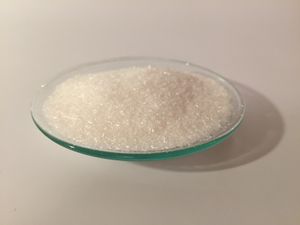Hydroquinone

| |
| Names | |
|---|---|
| IUPAC name
Benzene-1,4-diol
| |
| Other names
Hydroquinone
Idrochinone Quinol 1,4-Dihydroxybenzene 1,4-Hydroxy benzene | |
| Properties | |
| C6H6O2 | |
| Molar mass | 110.11 g/mol |
| Appearance | White crystalline solid |
| Odor | Odorless |
| Density | 1.33 g/cm3 |
| Melting point | 172 °C (342 °F; 445 K) |
| Boiling point | 287 °C (549 °F; 560 K) |
| 5.9 g/100 ml (15 °C) 7.2 g/100 ml (25 °C) 8.3 g/100 ml (30 °C) | |
| Solubility | Soluble in diethyl ether |
| Solubility in acetone | 28.4 g/100 g (30 °C) |
| Solubility in benzene | 0.06 g/100 g (30 °C) |
| Solubility in carbon tetrachloride | 0.01 g/100 g (30 °C) |
| Solubility in ethanol | 46.4 g/100 g (30 °C) |
| Vapor pressure | 0.00001 mmHg (20 °C) |
| Acidity (pKa) | 10.85 |
| Thermochemistry | |
| Hazards | |
| Safety data sheet | Sigma-Aldrich |
| Flash point | 165 °C |
| Lethal dose or concentration (LD, LC): | |
| LD50 (Median dose)
|
490 mg/kg (mammal, oral) 245 mg/kg (mouse, oral) 200 mg/kg (rabbit, oral) 320 mg/kg (rat, oral) 550 mg/kg (guinea pig, oral) 200 mg/kg (dog, oral) 70 mg/kg (cat, oral) |
| Related compounds | |
| Related compounds
|
Phenol |
| Except where otherwise noted, data are given for materials in their standard state (at 25 °C [77 °F], 100 kPa). | |
| Infobox references | |
Hydroquinone (C6H4(OH)2), also known as benzene-1,4-diol or quinol, is an aromatic organic compound, with a variety of uses in chemistry.
Substituted derivatives of this parent compound are also referred to as hydroquinones.
Contents
Properties
Chemical
Hydroquinone, like phenols are very weak acids and can be deprotonated.
Hydroquinone undergoes oxidation under mild conditions to give benzoquinone, process which is reversible.
Hydroquinone is highly susceptible to ring substitution by Friedel-Crafts reactions such as alkylation.
Physical
Hydroquinone is a white crystalline solid, poorly soluble in water, but more soluble in organic solvents.
Availability
HYdroquinone can be found in various skin care products. Classical photo shops also sell hydroquinone.
Hydroquinone is sold by chemical suppliers. It can also be found on eBay and Amazon.
Preparation
Hydroquinone can be made through several routes.
A common route involves hydroxylation of phenol. Hydrogen peroxide is used and the reaction gives a mixture of hydroquinone and catechol:
An accessible route involves the reaction of sodium hydroxide with 1,4-dichlorobenzene.
Projects
- Make metol
- Make esters
Handling
Safety
Hydroquinone is irritant.
Storage
In closed bottles.
Disposal
Can be destroyed by oxidizing it with an oxidizing mixture.